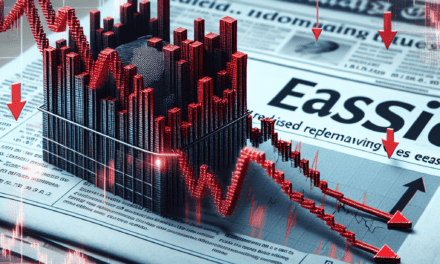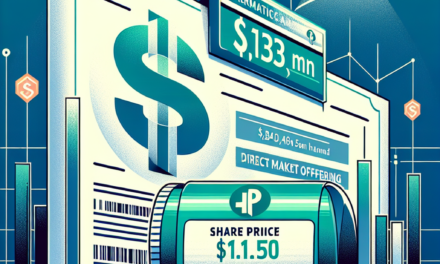“Traders Brace for Impact: Navigating the Fed’s Next Rate Moves.”
Introduction
Traders’ reactions to the Federal Reserve’s interest rate decisions are pivotal in shaping market dynamics and investor sentiment. As the Fed navigates economic indicators such as inflation, employment, and growth, its monetary policy adjustments can lead to significant fluctuations in asset prices. Market participants closely analyze the Fed’s communications, economic forecasts, and the broader economic landscape to anticipate potential rate changes. These reactions can manifest in various ways, including shifts in stock prices, bond yields, and currency valuations, reflecting traders’ expectations and strategies in response to the central bank’s actions. Understanding these reactions provides valuable insights into market psychology and the interconnectedness of monetary policy and financial markets.
Market Volatility Post-Fed Announcement
Market volatility often intensifies following announcements from the Federal Reserve regarding interest rate adjustments. Traders, who are acutely aware of the implications these decisions have on the economy, financial markets, and their own portfolios, react swiftly to any changes in monetary policy. When the Fed signals a potential increase or decrease in interest rates, the immediate aftermath can lead to significant fluctuations in stock prices, bond yields, and currency values. This volatility is not merely a reflection of the announcement itself but also of the market’s interpretation of the Fed’s future intentions and the broader economic context.
In the wake of a Fed announcement, traders typically analyze the language used by the central bank, as well as the economic indicators that influenced its decision. For instance, if the Fed raises interest rates in response to rising inflation, traders may anticipate further tightening measures, leading to a sell-off in equities as investors reassess the growth outlook. Conversely, if the Fed opts to lower rates to stimulate a sluggish economy, traders might react positively, driving stock prices higher as they seek to capitalize on the potential for increased consumer spending and business investment.
Moreover, the market’s reaction is often compounded by the prevailing sentiment among investors. If traders are already skittish due to geopolitical tensions or disappointing economic data, even a modest change in interest rates can trigger a more pronounced response. This phenomenon underscores the importance of market psychology, as fear and optimism can amplify price movements. As a result, the volatility observed post-announcement can sometimes appear disproportionate to the actual change in rates, reflecting the complex interplay between trader sentiment and economic fundamentals.
Additionally, the role of algorithmic trading cannot be overlooked in this context. Many traders rely on automated systems that react to news and data releases within milliseconds. These algorithms can exacerbate volatility, as they execute large volumes of trades based on predefined criteria. Consequently, a single Fed announcement can lead to a cascade of buying or selling, further destabilizing the market. This rapid-fire trading environment necessitates that human traders remain vigilant, as they must navigate the unpredictable landscape shaped by both algorithmic and discretionary trading.
As traders digest the implications of the Fed’s decisions, they also consider the potential ripple effects on various asset classes. For example, rising interest rates typically lead to higher yields on government bonds, which can draw capital away from equities. In contrast, lower rates may encourage investors to seek higher returns in riskier assets, such as stocks or corporate bonds. This dynamic creates a complex web of interdependencies that traders must navigate, often leading to shifts in sector performance and asset allocation strategies.
In conclusion, the market volatility that follows a Fed announcement is a multifaceted phenomenon driven by traders’ reactions to interest rate changes and the broader economic landscape. As they assess the implications of the Fed’s decisions, traders must remain agile, adapting their strategies to the evolving market conditions. This responsiveness is crucial in a landscape where sentiment, algorithmic trading, and economic indicators converge to create a dynamic and often unpredictable trading environment. Ultimately, understanding these reactions and their consequences is essential for navigating the complexities of post-Fed announcement volatility.
Historical Trends: Traders’ Responses to Rate Changes
Traders’ reactions to interest rate changes by the Federal Reserve have historically been a critical aspect of market dynamics, influencing not only stock prices but also bond yields and currency valuations. Understanding these reactions requires a look back at past rate adjustments and the subsequent market behavior. When the Federal Reserve announces a change in interest rates, traders often respond with immediate and sometimes volatile movements in various asset classes. This response is typically driven by the anticipated impact of the rate change on economic growth, inflation, and overall market sentiment.
For instance, during periods of rate hikes, traders often exhibit a cautious approach, reflecting concerns about potential slowdowns in economic activity. Historical data shows that when the Fed raises rates, equity markets may initially react negatively as investors reassess the future profitability of companies in a higher borrowing cost environment. This was evident during the rate increase cycle that began in December 2015, where the S&P 500 experienced heightened volatility as traders adjusted their expectations for corporate earnings in light of rising interest rates. The initial reaction often includes a sell-off in sectors that are sensitive to interest rates, such as utilities and real estate, which tend to underperform when borrowing costs rise.
Conversely, when the Fed lowers interest rates, traders typically respond with optimism, driving stock prices higher as the cost of borrowing decreases. This was particularly noticeable during the financial crisis of 2008-2009 when the Fed slashed rates to near-zero levels. The immediate aftermath saw a significant rally in equity markets as traders anticipated improved economic conditions and increased consumer spending. The historical trend indicates that rate cuts are often perceived as a signal of support for economic growth, leading to increased risk appetite among investors.
Moreover, the timing and communication surrounding rate changes play a crucial role in shaping traders’ responses. The Fed’s forward guidance, which provides insights into future monetary policy directions, can significantly influence market expectations. For example, during the 2018 tightening cycle, the Fed’s communication strategy was closely scrutinized by traders, who reacted not only to the rate changes themselves but also to the language used in the accompanying statements. When the Fed signaled a more dovish stance, traders often interpreted this as a sign of potential future rate cuts, leading to rallies in equity markets and declines in bond yields.
Additionally, traders’ reactions are often influenced by external factors, such as geopolitical events or economic data releases, which can exacerbate or mitigate the impact of rate changes. For instance, during the trade tensions between the United States and China, traders were particularly sensitive to Fed announcements, as they sought to gauge the potential impact of monetary policy on economic growth amid uncertainty. This interplay between interest rate changes and external economic factors highlights the complexity of market reactions and the need for traders to remain vigilant and adaptable.
In conclusion, historical trends reveal that traders’ responses to the Federal Reserve’s interest rate changes are multifaceted and influenced by a variety of factors, including economic conditions, sector sensitivities, and communication strategies. As traders navigate these dynamics, their reactions can lead to significant market movements, underscoring the importance of understanding the broader economic context in which these rate changes occur. Ultimately, the interplay between monetary policy and market sentiment remains a critical area of focus for traders seeking to anticipate future market behavior.
Sector-Specific Reactions to Interest Rate Hikes
As traders closely monitor the Federal Reserve’s interest rate decisions, the implications of these moves ripple through various sectors of the economy, eliciting distinct reactions from market participants. When the Fed signals an intention to raise interest rates, the immediate response often varies significantly across sectors, reflecting the unique sensitivities and dynamics inherent to each industry. For instance, the financial sector typically welcomes interest rate hikes, as higher rates can lead to improved net interest margins for banks and financial institutions. This is particularly true for traditional banks that rely on the spread between the interest they pay on deposits and the interest they earn on loans. Consequently, traders in this sector may react positively, driving up stock prices in anticipation of increased profitability.
Conversely, the real estate sector tends to react negatively to rising interest rates. Higher borrowing costs can dampen demand for mortgages, leading to a slowdown in home sales and a potential decline in property values. As traders in the real estate investment trusts (REITs) and housing markets assess the implications of increased rates, they often adjust their positions accordingly, leading to a sell-off in real estate stocks. This reaction underscores the sensitivity of the sector to changes in interest rates, as higher costs can significantly impact both consumer behavior and investment strategies.
In addition to financial and real estate sectors, the consumer discretionary sector also exhibits notable reactions to interest rate hikes. As borrowing costs rise, consumers may curtail spending on non-essential goods and services, which can adversely affect companies in this sector. Traders often anticipate a slowdown in consumer spending, leading to a cautious approach in their investment strategies. Retail stocks, particularly those reliant on credit for sales, may experience downward pressure as traders reassess growth projections in light of potential declines in consumer confidence and spending power.
On the other hand, the utilities sector often displays resilience in the face of rising interest rates. Utilities are typically seen as stable investments, providing consistent dividends that can attract income-seeking investors even when rates increase. However, the sector is not entirely immune to the effects of rate hikes. As interest rates rise, the cost of capital for utility companies may increase, potentially impacting their ability to finance new projects. Traders in this sector may adopt a more cautious stance, weighing the balance between stable income and the potential for increased financing costs.
Moreover, the technology sector presents a complex landscape in response to interest rate changes. While some technology companies may benefit from increased consumer spending and investment in innovation, others, particularly those with high valuations based on future earnings, may face headwinds. As interest rates rise, the present value of future cash flows diminishes, leading traders to reassess the valuations of growth-oriented tech stocks. This can result in increased volatility as market participants navigate the delicate balance between growth potential and rising costs of capital.
In summary, traders’ reactions to the Federal Reserve’s interest rate moves are deeply influenced by sector-specific dynamics. While financial institutions may thrive in a higher rate environment, sectors like real estate and consumer discretionary often face challenges. Utilities may offer stability, while technology stocks can experience mixed reactions based on their growth profiles. As traders analyze these sector-specific responses, they must remain vigilant, adapting their strategies to the evolving economic landscape shaped by the Fed’s decisions.
The Role of Economic Indicators in Trader Sentiment
Traders’ reactions to the Federal Reserve’s interest rate decisions are significantly influenced by a variety of economic indicators, which serve as critical barometers of the overall health of the economy. These indicators, including employment figures, inflation rates, and consumer spending, provide traders with essential insights that shape their expectations and strategies. As the Fed contemplates its next moves, the interplay between these economic metrics and trader sentiment becomes increasingly pronounced.
To begin with, employment data is one of the most closely monitored indicators by traders. The monthly jobs report, which includes metrics such as the unemployment rate and non-farm payrolls, offers a snapshot of the labor market’s strength. A robust jobs report typically signals economic growth, leading traders to anticipate that the Fed may raise interest rates to prevent the economy from overheating. Conversely, disappointing employment figures can prompt fears of a slowdown, resulting in traders adjusting their positions in anticipation of a more dovish stance from the Fed. Thus, the employment landscape not only reflects current economic conditions but also shapes traders’ expectations regarding future monetary policy.
In addition to employment data, inflation rates play a pivotal role in influencing trader sentiment. The Consumer Price Index (CPI) and the Personal Consumption Expenditures (PCE) index are two key measures that the Fed closely monitors to gauge inflationary pressures. When inflation rises above the Fed’s target, traders often react by pricing in potential interest rate hikes, as the central bank may feel compelled to act to maintain price stability. On the other hand, if inflation remains subdued, traders may interpret this as a signal for the Fed to maintain or even lower interest rates, fostering a more accommodative monetary environment. Consequently, fluctuations in inflation data can lead to swift adjustments in trader sentiment and market positioning.
Moreover, consumer spending is another vital economic indicator that traders consider when assessing the Fed’s potential actions. As consumer spending accounts for a significant portion of economic activity, strong retail sales figures can bolster confidence in the economy’s resilience. In such scenarios, traders may predict that the Fed will adopt a more hawkish approach, aiming to curb inflationary pressures that could arise from increased demand. Conversely, weak consumer spending can raise concerns about economic stagnation, prompting traders to anticipate a more cautious stance from the Fed. This dynamic illustrates how interconnected economic indicators can influence trader sentiment and expectations regarding interest rate movements.
Furthermore, the global economic landscape also plays a crucial role in shaping traders’ reactions to the Fed’s decisions. Economic developments in major economies, such as the Eurozone and China, can have ripple effects on U.S. markets. For instance, signs of economic weakness abroad may lead traders to expect that the Fed will prioritize economic stability over aggressive rate hikes, thereby influencing their trading strategies. This interconnectedness underscores the importance of a comprehensive analysis of both domestic and international economic indicators in understanding trader sentiment.
In conclusion, the role of economic indicators in shaping trader sentiment regarding the Fed’s interest rate moves cannot be overstated. Employment figures, inflation rates, and consumer spending all serve as critical inputs that inform traders’ expectations and strategies. As these indicators fluctuate, they create a dynamic environment where traders must continuously adapt to new information, ultimately influencing market behavior and the broader economic landscape. Understanding this intricate relationship is essential for grasping the complexities of financial markets and the factors that drive trader reactions to monetary policy decisions.
Strategies for Traders During Fed Rate Decisions
As traders navigate the complexities of financial markets, the Federal Reserve’s interest rate decisions remain a pivotal factor influencing their strategies. Understanding the implications of these decisions is crucial for traders seeking to optimize their positions and manage risk effectively. When the Fed signals a potential change in interest rates, traders must adapt their strategies to align with the anticipated market movements. This adaptability is essential, as the reactions of various asset classes can vary significantly based on the nature of the Fed’s announcements.
One of the primary strategies traders employ during Fed rate decisions is to closely monitor economic indicators leading up to the announcement. Key metrics such as inflation rates, employment figures, and GDP growth provide valuable insights into the Fed’s potential course of action. For instance, if inflation is rising faster than expected, traders might anticipate a rate hike and position themselves accordingly in interest-sensitive assets like bonds and equities. Conversely, if economic data suggests a slowdown, traders may prepare for a dovish stance from the Fed, which could lead to a rally in riskier assets.
In addition to analyzing economic indicators, traders often utilize options strategies to hedge against volatility surrounding Fed announcements. The uncertainty that precedes a rate decision can lead to increased market volatility, making options an attractive tool for managing risk. By employing strategies such as straddles or strangles, traders can position themselves to benefit from significant price movements in either direction. This approach allows them to capitalize on the market’s reaction, regardless of whether the Fed raises or lowers rates.
Moreover, understanding market sentiment is crucial for traders during these pivotal moments. The Fed’s communications, including statements and press conferences, can significantly influence trader psychology. Traders often analyze the language used by Fed officials to gauge the central bank’s outlook on the economy. For example, a more hawkish tone may prompt traders to sell off equities in favor of safer assets, while a dovish tone could lead to increased buying in the stock market. By staying attuned to these nuances, traders can make informed decisions that align with prevailing market sentiment.
Another effective strategy involves diversifying portfolios in anticipation of potential rate changes. Traders may consider reallocating their investments across various asset classes, such as commodities, currencies, and equities, to mitigate risk. For instance, if a rate hike is anticipated, traders might increase their exposure to sectors that historically perform well in a rising rate environment, such as financials. Conversely, if a rate cut is expected, they may shift their focus to growth-oriented sectors that benefit from lower borrowing costs.
Finally, it is essential for traders to remain disciplined and avoid emotional decision-making during periods of heightened uncertainty. The volatility surrounding Fed announcements can lead to impulsive trading behaviors, which may result in significant losses. By adhering to a well-defined trading plan and employing risk management techniques, traders can navigate the complexities of the market with greater confidence.
In conclusion, traders’ reactions to the Fed’s interest rate decisions are shaped by a combination of economic analysis, market sentiment, and strategic positioning. By employing a range of strategies, including monitoring economic indicators, utilizing options for hedging, diversifying portfolios, and maintaining discipline, traders can effectively respond to the dynamic landscape created by the Fed’s actions. Ultimately, a proactive and informed approach will enable traders to capitalize on opportunities while managing the inherent risks associated with interest rate fluctuations.
Psychological Impact of Rate Changes on Market Behavior
The psychological impact of interest rate changes on market behavior is a critical aspect that traders must navigate in the complex landscape of financial markets. When the Federal Reserve announces a shift in interest rates, whether an increase or a decrease, it sends ripples through the market that can significantly influence trader sentiment and decision-making processes. This phenomenon is rooted in the broader economic implications of such changes, as interest rates serve as a barometer for economic health and future growth prospects.
To begin with, interest rate adjustments are often perceived as signals of the Fed’s outlook on the economy. For instance, a rate hike may be interpreted as a response to rising inflation or an overheating economy, prompting traders to reassess their positions. Conversely, a rate cut might suggest that the Fed is attempting to stimulate growth in a sluggish economy. This interpretation can lead to a shift in market sentiment, as traders adjust their strategies based on perceived risks and opportunities. Consequently, the psychological impact of these decisions can lead to increased volatility in the markets, as traders react not only to the changes themselves but also to the anticipated effects on corporate earnings and consumer spending.
Moreover, the timing of these rate changes plays a crucial role in shaping trader behavior. Traders often engage in speculative activities based on their expectations of future rate movements. For example, if traders anticipate a rate hike, they may begin to sell off equities in advance, leading to a decline in stock prices even before the official announcement. This preemptive behavior underscores the importance of market psychology, as traders are not merely reacting to the Fed’s decisions but are also influenced by their expectations and the prevailing narratives within the market. As a result, the psychological dynamics at play can create a self-fulfilling prophecy, where anticipated market movements lead to actual changes in asset prices.
In addition to individual trader reactions, the collective behavior of market participants can amplify the psychological impact of rate changes. When a significant number of traders adopt a similar outlook—whether bullish or bearish—it can create momentum that drives market trends. This herd mentality can lead to exaggerated price movements, as traders rush to align their positions with the prevailing sentiment. Consequently, the psychological effects of interest rate changes can extend beyond immediate reactions, influencing longer-term market trends and investor confidence.
Furthermore, the communication strategies employed by the Federal Reserve also play a pivotal role in shaping trader psychology. The clarity and transparency of the Fed’s messaging can either mitigate or exacerbate market reactions. For instance, if the Fed provides clear guidance on its future policy intentions, traders may feel more secure in their decision-making, leading to more measured responses. On the other hand, ambiguous or contradictory signals can create uncertainty, prompting traders to react more impulsively. This highlights the importance of effective communication in managing market expectations and minimizing psychological stress among traders.
In conclusion, the psychological impact of interest rate changes on market behavior is a multifaceted phenomenon that encompasses individual trader reactions, collective market dynamics, and the influence of the Federal Reserve’s communication strategies. As traders navigate the complexities of interest rate adjustments, understanding these psychological factors becomes essential for making informed decisions in an ever-evolving market landscape. Ultimately, the interplay between economic indicators and trader sentiment underscores the intricate relationship between monetary policy and market behavior, shaping the financial landscape in profound ways.
Predictions for Future Rate Moves and Trader Adjustments
As traders closely monitor the Federal Reserve’s monetary policy, predictions regarding future interest rate moves have become a focal point of market speculation. The Fed’s decisions are pivotal, influencing not only the economy but also the behavior of traders across various asset classes. In light of recent economic indicators, including inflation rates and employment figures, traders are adjusting their strategies in anticipation of the Fed’s next moves.
The current economic landscape presents a complex picture, with inflation remaining a primary concern for the Fed. As inflationary pressures persist, traders are increasingly factoring in the likelihood of further rate hikes. Market analysts suggest that the Fed may adopt a more hawkish stance, particularly if inflation does not show signs of abating. Consequently, traders are recalibrating their portfolios, favoring sectors that typically perform well in a rising interest rate environment, such as financials and certain commodities. This shift reflects a broader understanding that higher rates can lead to increased borrowing costs, which may dampen consumer spending and slow economic growth.
Moreover, the Fed’s communication strategy plays a crucial role in shaping trader expectations. The central bank’s forward guidance, which outlines its outlook on the economy and interest rates, is closely scrutinized by market participants. Any hints of a more aggressive tightening cycle can lead to immediate reactions in the markets, as traders adjust their positions to mitigate risk. For instance, if the Fed signals a commitment to combating inflation through rate hikes, traders may respond by selling off bonds, anticipating that yields will rise. This reaction can create ripple effects across equity markets, as higher interest rates often lead to lower valuations for growth stocks.
In addition to interest rate predictions, traders are also considering the potential impact of geopolitical events and fiscal policies on the Fed’s decision-making process. Uncertainties surrounding trade relations, global economic conditions, and domestic fiscal measures can all influence the Fed’s approach to interest rates. As such, traders are adopting a more cautious stance, employing strategies that allow for flexibility in response to unexpected developments. This adaptability is essential in a market environment characterized by volatility and rapid changes in sentiment.
Furthermore, the use of derivatives has become increasingly prevalent among traders seeking to hedge against potential rate changes. Options and futures contracts provide a means to manage risk associated with interest rate fluctuations, allowing traders to protect their investments while maintaining exposure to potential gains. This strategic use of financial instruments underscores the importance of risk management in an environment where the Fed’s actions can lead to significant market shifts.
As the Fed prepares for its next policy meeting, traders will continue to analyze economic data and adjust their strategies accordingly. The interplay between interest rate expectations and market reactions will remain a critical area of focus. Ultimately, the ability to anticipate and respond to the Fed’s moves will be paramount for traders seeking to navigate the complexities of the financial markets. In this dynamic landscape, informed decision-making and strategic foresight will be essential for capitalizing on opportunities while mitigating risks associated with the Fed’s evolving monetary policy. As the situation unfolds, traders will remain vigilant, ready to adapt to the ever-changing economic environment shaped by the Fed’s actions.
Q&A
1. **Question:** How do traders typically react to anticipated interest rate hikes by the Fed?
**Answer:** Traders often sell bonds and equities, anticipating higher borrowing costs and potential economic slowdowns.
2. **Question:** What is the common market sentiment when the Fed signals a pause in interest rate increases?
**Answer:** Traders usually respond positively, leading to a rally in stocks as the outlook for economic growth improves.
3. **Question:** How do traders adjust their portfolios in response to unexpected interest rate cuts?
**Answer:** Traders may increase their exposure to riskier assets, such as stocks, as lower rates can stimulate economic activity.
4. **Question:** What impact do interest rate forecasts have on currency markets?
**Answer:** Traders often react by buying or selling currencies based on expected interest rate differentials, influencing exchange rates.
5. **Question:** How do traders interpret the Fed’s forward guidance on interest rates?
**Answer:** Traders analyze the language and tone of the guidance to gauge the Fed’s future policy direction, adjusting their strategies accordingly.
6. **Question:** What is the effect of interest rate changes on commodity prices from a trader’s perspective?
**Answer:** Traders may buy or sell commodities based on anticipated changes in interest rates, as higher rates can strengthen the dollar and lower commodity prices.
7. **Question:** How do traders use economic indicators to predict Fed interest rate moves?
**Answer:** Traders closely monitor indicators like inflation and employment data to forecast potential rate changes and adjust their trading strategies.
Conclusion
Traders’ reactions to the Fed’s next interest rate moves are likely to be influenced by economic indicators, inflation data, and overall market sentiment. Anticipation of rate hikes may lead to increased volatility in equity and bond markets, as investors adjust their portfolios in response to potential changes in borrowing costs and economic growth expectations. Ultimately, traders will closely monitor the Fed’s communications and economic developments to gauge the timing and magnitude of interest rate adjustments, which will significantly impact market dynamics.





